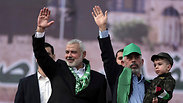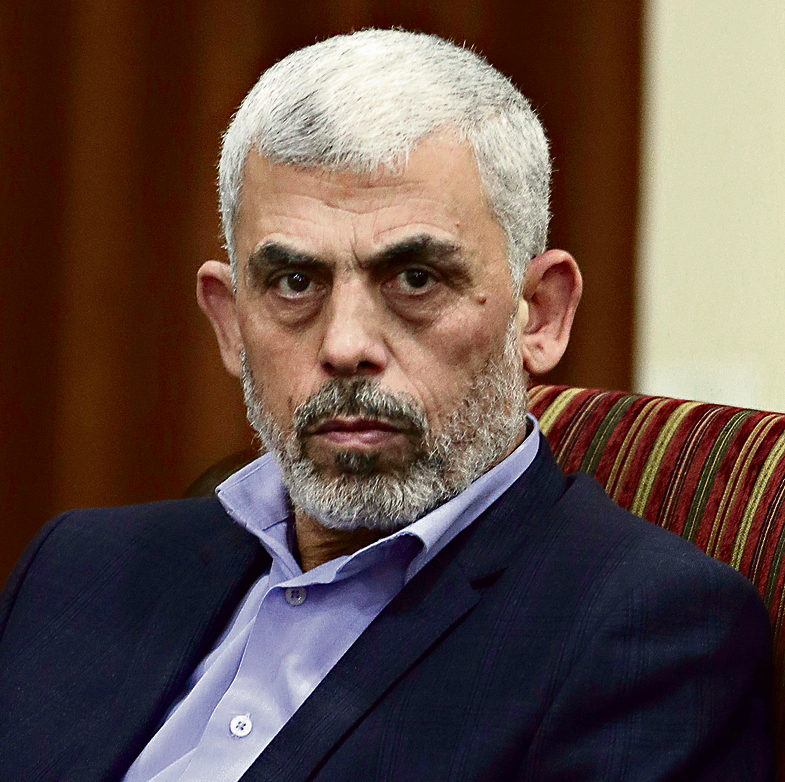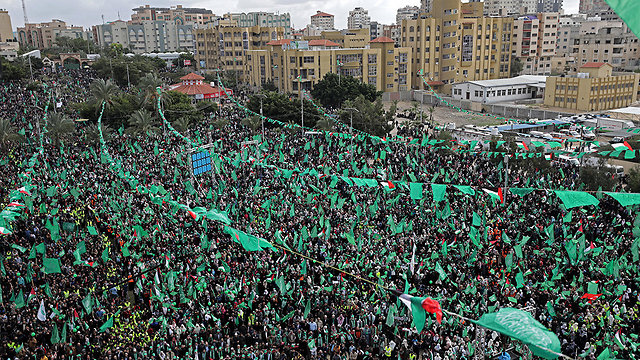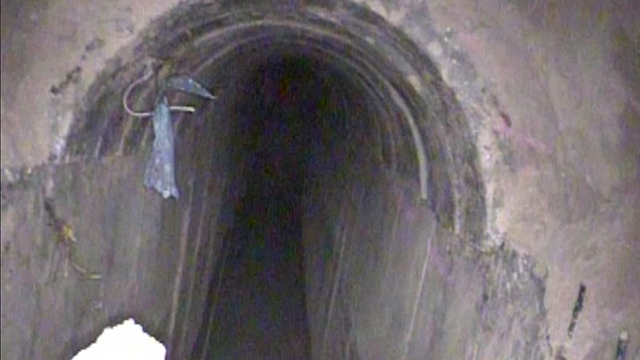

The new threats at the end of the tunnel
Analysis: The latest exposure of a cross-border attack tunnel made it clear to Hamas that it’s about to lose its most strategic weapon in Gaza; the alternative options considered by the terror organization include upgraded rockets, quadcopters armed with explosive charges, underwater tunnels and using car bombs to break through the obstacle being built by the IDF.
One would expect him to appear in public, present achievements and inflame the Palestinian street following US President Donald Trump’s recognition of Jerusalem as Israel’s capital, but the man and the group surrounding him were somewhere else. Until last Thursday afternoon, when Sinwar showed up on the stage at a mass rally in Gaza, facing 100,000 Hamas supporters.
Israeli officials took note of Sinwar’s temporary disappearance. No one can provide an explanation as to why the Hamas leader and his people vanished, and that is quite concerning. In the past, such unusual behavior pointed to a change of direction in the struggle, to an impending conflict.
Sinwar is not just a military leader. He is Hamas’ elected leader in the Gaza Strip, and essentially in the West Bank too. His absence from the public arena, just as he gets the opportunity to inflame the West Bank and gain power, is unnatural. His public in Gaza and the West Bank is being incited by the people he beat in the elections. He left the stage to the opposition, Khaled Mashal and his associates. Even Ismail Haniyeh, who replaced Mashal as head of the political bureau and who has almost zero political power, took control of the microphones.
Sinwar’s disappearance from the public spotlight began around the time of Trump’s announcement, on October 6. This kind of behavior, going to ground, is typical of a leadership preparing for an IDF offensive. They likely took into account that if Israeli citizens got killed as a result of rocket fire, Israel would use its heaviest deterrence weapon: A targeted assassination of the Hamas leadership in the strip.
At the moment, there is no substantial change in Hamas’ military moves. The organization evacuated its men from the frontline posts for fear of direct Israeli tank fire. Most of the rockets fired at Israel since Trump’s speech have been launched by Salafi organizations using locally-produced short-range rockets. It’s still unclear who launched the rocket that hit Sderot, and Hamas members may have been involved, but the organization doesn’t seem particularly happy with this wave of rocket fire.
On the one hand, Hamas is encouraging protests on the border fence and isn’t so strict about limiting rocket fire. On the other hand, the organization is still carrying out arrests among Salafi organizations. In any event, the smell of gunpowder is in the air. It’s enough that one incident gets out of control—whether a rocket kills someone or an Air Force strike diverts from its target—and the Hamas forces seeking to make use of the tunnels as long as they are effective will grow.
There is another possible explanation for this temporary “disappearance” of the Hamas leadership. Since the beginning of the year, the organization’s heads have been struggling with a key strategic issue: What should they do when Israel finds an effective response to the tunnel weapon?
Earlier this month, after Israel uncovered and neutralized a Hamas attack tunnel near Kibbutz Nirim, the matter became critical: Should they increase the pace of digging and try to infiltrate Israel even before the obstacle project is completed, or should they give up the attack tunnels and start investing in other capabilities that could go around the obstacle and present a new deterring threat to Israel?
The Hamas leaders are likely racking their brains together and holding urgent discussions on the Israeli solution, which is why they “vanished.” The obstacle includes sensors, and Hamas is trying to study the system and collect accurate intelligence on it.
Hamas got the message
In July-August, Israel began building the obstacle on six points along the border simultaneously. Hamas realized that the speed of the obstacle construction could leave the organization without cross-border tunnels by the end of 2018. Hamas, and Islamic Jihad, began devising plans to sabotage the work, but the sabotage attempts were thwarted by the IDF’s offensive and defensive activities.
The heads of Israel's defense establishment warned Hamas, both covertly and publicly, no to disrupt the work conducted on Israeli territory. At the same time, the other side saw military forces deploying opposite the Gaza fence and heard manned and unmanned aerial vehicles flying over its head throughout many hours of the day. On November 30, Islamic Jihad launched a failed attempt to sabotage the work in an alleged attempt to avenge the killing of 12 of its people in a tunnel demolished by the IDF a month earlier. In general, however, the Gaza factions got the message.
The realization that they were about to lose their main strategic weapon hit the strip’s terror organizations when the two tunnels—Hamas and the Islamic Jihad’s—were destroyed. The reports that IDF Chief of Staff Gadi Eisenkot had ordered the army to destroy all cross-border tunnels by the end of 2018 made them realize that Eisenkot holds a solution allowing him to issue such an order. If they fail to do something about it soon, another tunnel will be destroyed every few weeks.
This realization came as a major blow to Hamas, as most of its military wing’s budget had been invested in the tunnel project. The excavation of a 2-3-kilometer-long attack tunnel took two-to-five years, depending on the type of land and resources. The cost of building one tunnel was NIS 10-15 million, depending on its length. In Gazan terms, that’s a lot of money. More than 30 cross-border tunnels in different construction stages were uncovered during Operation Protective Edge. As a result, the Iranians’ entire annual security aide to Hamas in Gaza—$60 million—went down the drain.
To construct an attack tunnel, the Gaza groups need to build a concrete plant, buy huge amounts of cement, transport the materials and evacuate the sand on railway cars, rent buildings from which the tunnel comes out of and purchase large air-conditioning and electricity systems. Some of the tunnels have elevators, which lead the militants dozens of meters underground. Some allow an infiltration with motorcycles, so they must be wide.
The tunnel diggers work three different shifts, and their salaries are relatively high compared to the average wage in Gaza, due to the dangerous nature of the job. While a government worker in the strip earns about NIS 1,800 a month, a tunnel digger could earn double. Dozens of people have already been killed and hundreds have been injured during the digs, and the terror organizations pay huge sums in damages to their families.
Israel’s citizens are naturally focusing on the attack tunnels, but Hamas is equally concerned—and perhaps even more concerned—about the future of the internal tunnels located dozens of kilometres under the strip, which serve as the heart of the military wing’s defense plan against a possible Israeli occupation of Gaza.
These are the tunnels that connect the fronts, it’s where the commands are located, where the military force goes to take cover during airstrikes, where some of the rockets are launched from, where the fighters will burst out of to attack Israeli forces and kidnap soldiers during a ground invasion (that’s how Hadar Goldin’s body was taken in Operation Protective Edge). If Israel has the ability to detect a tunnel, map it and destroy it, these tunnels will also be threatened in the event of a ground operation.
Israel, however, isn’t quick to rejoice about the technological achievements and the abilities developed against the tunnels, perhaps so as not to jinx it or because the enemy could be hiding another trick up his sleeve. And most importantly, Israel doesn’t want to encourage Hamas to make decisions that will make the organization stop playing by the rules. The anti-tunnel systems are still in an evolutionary development process, Israeli officials say cautiously, but the direction seems promising.
What next?
With its entire military worldview collapsing, Hamas is at a crossroad: What next? This has been the worst year in the organization’s history. Not only is it beginning to lose the tunnels as a weapon, but the Shin Bet has clipped its wings in the West Bank and prevented a significant terror attack, despite the incitement and funds flowing into the strip from Turkey and the Gulf emirates.
In the first 11 months of the year, the Shin Bet thwarted 130 Hamas cells in the West Bank. Earlier this month, it was cleared for publication that Israel had foiled a plan to kidnap a soldier during the holiday of Hanukkah. The incitement coming out of Gaza, which is aimed at encouraging lone-wolf terrorists, is being curbed by the IDF and Shin Bet as well. Every week, 25 to 30 lone-wolf attacks are thwarted.

In the five days after Trump’s announcement, the number of attacks spiked to more than 90 incidents of different types: Molotov cocktails, arson, shooting, stabbing, rockets and explosive devices. Nevertheless, the Israeli society continued its normal life. As far as Hamas is concerned, that’s a failure. Hamas will likely try to carry out major attacks in honor of its 30th anniversary celebrations, but its attempts to build a significant infrastructure in the West Bank have failed.
The Israeli race against the tunnels is about to end. The next threat from the strip is waiting around the corner. Hamas doesn’t have many options for getting around the Israeli obstacle after the tunnel era. If Gaza is a reflection of what Hezbollah is doing, we should examine what the Lebanese terror organization did during the fighting in Syria.
One of the ways to get around an obstacle is a remote-piloted vehicle, or the technological hit adopted by all armies of the world: Quadcopters. In the war in Syria, Hezbollah used armed quadcopters that carry explosives and release them above a certain target or crash into it, while a camera allows the operator to choose the target and direct the quadcopter to it. A quadcopter can be operated by any child, and the advancements allowing quadcopters to carry weapons keep improving.
And not just Hezbollah. The Islamic State, for example, used armed quadcopters against the Iraqi army in Mosul. Every few minutes, they released three or four quadcopters that exploded in certain points. If this technique is copied to the strip, and explosive quadcopters start falling on Israeli communities or traffic routes every few minutes, it will sow panic among the residents. Hamas is already making a major effort to smuggle quadcopters into the strip, the UAVs and the RPVs destroyed in Operation Protective Edge are much more complicated and difficult to smuggle.
The quadcopter is hard to detect and intercept, as its radar profile is similar to that of a stealth aircraft, but there already are solutions for that in the world. If and when the IDF is forced to deal with quadcopters, Israel’s defense industries will likely be waiting with reasonable solutions.
Larger quadcopters, which could carry a human being, are already being developed in the world, by the way. These developments are aimed, first and foremost, at solving transportation problems, but the option of using them for military purposes—transferring an armed person from one place to another and evading an obstacle—is coming up.
Another option Hamas can focus on is known as “the underwater tunnel,” secretly crossing the sea. In December 2016, flight engineer Mohammad al-Zawari was assassinated in Tunisia. He was hailed as the father of Hamas’ drone program, but the eulogies published in the Arab press after his death mentioned his developments in the underwater field as well, like manned and unmanned midget submarines.
Hamas’ naval force keeps developing. One of the main targets bombed by the IAF in Gaza in recent days was one of the naval force's equipment warehouses. At the same time, Hamas is focusing its efforts on smuggling naval fighting equipment to the strip. The Israeli response to this option lies both in the Navy’s offensive abilities and in defensive areas, like deploying sensors along the shore and in the sea to try to locate vessels, swimmers and divers who would try to reach Israel’s shores to try to carry out a massacre.
Another possibility is an attempt to forcibly break through the obstacle being built by the IDF. Even if there are no intelligence warnings to that end, the IDF must be prepared for such a situation. We have already seen Hamas attacks in the southern strip and ISIS attacks from Sinai aimed at breaking through the border and forcibly infiltrating Israel. A car bomb or truck bomb explode on the obstacle, one force widens the breach and another force enters Israel. There’s no doubt that Hamas’ special Nokhba forces have been practicing such operations with different vehicles, including motorcycles. A surprise operation of this kind could be effective. The IDF, we are told, is capable of dealing with this option through look outs and the use of fire.
And there also is the developing cyber warfare in the strip.
We may also assume that Hamas has other surprises in store, not to mention the means it already possesses, like antitank missiles, rockets with particularly heavy warheads, which could infiltrate fortified buildings in the Gaza border area, and long-range missiles threatening central Israel.
Israel is trying to lower the flames. In a recent visit to Sderot, Defense Minister Avigdor Lieberman left the impression he is interested in a moderate response to the rocket fire, which won’t lead to escalation. But the political-economic distress Hamas may experience if the reconciliation process fails, and the loss of its security assets, could push Sinwar and his people into a corner, and their only way out would be another round of hostilities against Israel. So the recent drizzle of rockets in the Gaza border could mean much more than simply an act of blowing off steam by Salafi organizations.


















